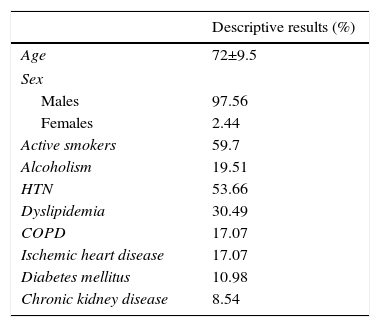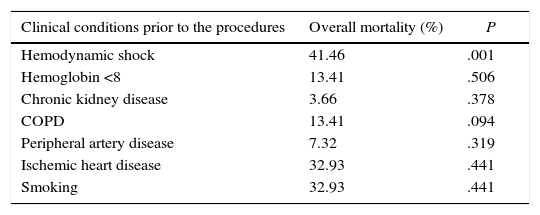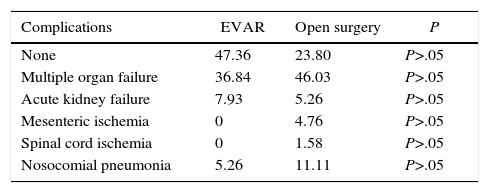Rupture of abdominal aortic aneurysm is still a difficult challenge for the vascular surgeon due to the high perioperative mortality. The aim of our study is to describe the characteristics of the population as well as to compare morbidity and mortality in patients undergoing open surgery or endovascular repair in our center.
MethodsDatabase with 82 rAAA between January 2002 and December 2014, studying two cohorts, open surgery and endovascular repair. Epidemiologic, clinical, surgical techniques, perioperative mortality and complications are analyzed.
ResultsEighty-two rAAA cases were operated (men: 80, women: 2). Mean age 72±9.6 years. 76.8% (63 cases) was performed by open surgery.
Backgroundsmokers 59, 7%, alcoholism 19.5%, DM 10.9%, AHT: 53.6%, dyslipidemia 30.5%. The most frequent clinical presentation was abdominal pain with lumbar irradiation: 50 cases (20.7% associating syncope). Overall hospital mortality was 58.5%. Hemodynamic shock prior to intervention was associated with increased mortality (P<.001). Anemia, leukocytosis, aneurysm size, sex and age did not show a statistically significant difference with respect to mortality (P>.05). The presence of iliac aneurysms was associated with increased mortality (P<.0045). Perioperative mortality in endovascular repair was 42%, and in open surgery was 63.5% (P>.05). Hospital stay was lower in the endovascular group (P=.3859).
ConclusionsHemodynamic shock and the presence of concomitant iliac aneurysms have a statistically significant association with perioperative mortality in both groups. We found clinically significant differences in mortality, complications and hospital stay when comparing both groups with better results for EVAR, without statistically significant differences.
La rotura del aneurisma aórtico (AAAr) continúa siendo un reto para el cirujano, presentando una alta mortalidad perioperatoria. El objetivo de nuestro estudio es describir el tipo de población afectada comparando mortalidad y complicaciones en pacientes intervenidos mediante cirugía abierta y reparación endovascular (REVAr) en nuestro centro.
MétodosBase de datos con 82 AAAr intervenidos entre enero de 2002-diciembre de 2014, estudiándose 2 cohortes, una intervenida mediante cirugía abierta y otra con REVAr. Se analizan variables demográficas, clínicas, técnicas quirúrgicas, complicaciones y mortalidad perioperatorias.
ResultadosOchenta y dos casos de AAAr intervenidos (varones: 80, mujeres: 2). Edad media 72±9,6 años. El 76,8% se realizó mediante cirugía abierta. Antecedentes: tabaco: 59,7%, alcoholismo: 19,5%, DM: 10,9%, HTA: 53,6%, dislipemia 30,5%. La clínica de presentación más frecuente fue dolor abdominal con irradiación lumbar: 71,9% (asociando síncope 20,7%). Mortalidad intrahospitalaria global 58,5%. El shock hemodinámico previo a intervención se asocia a una mayor mortalidad (p<0,001). La anemia, leucocitosis, antecedentes médicos, tamaño aneurismático, sexo y edad no muestran asociación significativa con respecto a la mortalidad (p>0,05). La presencia de aneurismas iliacos se asocia a mayor mortalidad (p=0,0045). Mortalidad perioperatoria para REVAr: 42%, y en cirugía: 63,5% (p>0,05). Estancia media menor en el grupo de REVAr (p>0,05).
ConclusionesEl shock hemodinámico y la presencia de aneurismas iliacos parecen asociarse a una mayor mortalidad en ambos grupos. Encontramos diferencias clínicamente significativas en cuanto a mortalidad, complicaciones y estancia hospitalaria al comparar ambos grupos con mejores resultados para EVAR, sin embargo no son estadísticamente significativas.












